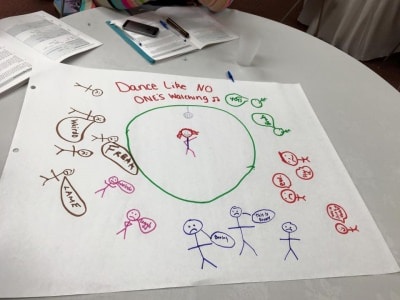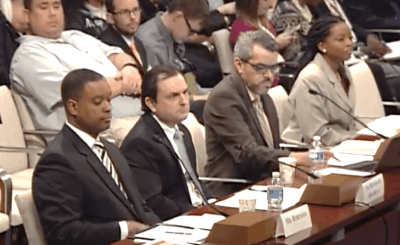Aron Gabriel, assistant superintendent of Newton-Conover City Schools, hears the arguments against raising the dropout age in North Carolina from 16 to 18.
Why waste resources on students who don’t want to learn? What’s the cost for local school systems already stretched thin by state budget shortfalls? And should students acting as family breadwinners be forced to sit in a classroom every day?
Gabriel hears it, but now that his school system has tested the model for almost two academic years, there’s a clear choice to him.
“Morally, professionally and ethically, this is the right thing to do,” says Gabriel.
Gabriel’s system is one of two, including Hickory Public Schools, in North Carolina participating in a two-year pilot program to test the model.
After launching the program, both Hickory and Newton-Conover school systems, located in western North Carolina in Catawba County, reported increases in 2014-2015 in their four-year cohort graduation rates, an analysis of high school completion that factors in students moving in or out of the school system. Newton-Conover’s rate, exceeding 95 percent in 2014-2015, was the highest in the state’s history, say school administrators.
The results in Hickory are somewhat harder to see at this point, given the limited amount of data available. Hickory’s graduation rate, at 83.9 percent, falls just short of the statewide rate of about 85.6 percent, but that’s a slight improvement—about 1 percentage point—from the previous year.
Yet the two school systems’ interim report in January to members of the State Board of Education came and went quietly, just as discussions of the dropout age often do in North Carolina, one of just 16 states in the U.S. that still maintains a minimum dropout age of 16.
N.C. Rep. Graig Meyer, a Democrat from Orange County and former school administrator who specialized in racial achievement disparities, co-sponsored bipartisan legislation last year to raise the dropout age statewide, although the bill stalled in the House education committee.
Meyer balked at any reticence on the proposal last week, although he could not say whether he expects the issue to be revived this year. Sen. Josh Stein, a Democrat from Wake County and a member of the Senate education committee, said he’s never even heard the idea mentioned on the Senate side of the legislature.
“I can’t take it seriously if someone thinks we should keep the dropout age at 16,” Meyer said last week. “That just means they’re putting money in front of children’s lives.”
Just how much money is a clear question: Supporters of the program in Hickory and Newton-Conover had no figures to go along with their presentation last month, but as most education advocates note, schools are funded on a per-pupil allotment. Thus, the larger the school system, the more per-pupil funding is available to address the problem, although most education advocates will point out the state’s per-pupil funding ranks a dismal 46th in the country.
In Newton-Conover, the system reassigned one staff member to act specifically to lead the dropout prevention program, Gabriel said. Otherwise, he said the change required the investment of mostly time and effort.
Gabriel added that his system did become considerably more targeted with its use of funding budgeted for “at-risk” students.
Still, following last month’s report, the state board’s vice chairman, A.L. Collins, groused that there needs to be an “awful lot of discussion” on the program before leaders raise the dropout age statewide.
Collins, who did not respond to interview requests from Policy Watch, pointed out both Newton-Conover and Hickory school systems are relatively small school systems during last month’s state board meeting. Indeed, the two Catawba County school systems combined serve a population of less than 8,000.
Fitting the model to a larger school system, such as Wake County, which serves more than 153,000 students, is a different challenge, he said, one that Gabriel openly acknowledged.
But Gabriel said the program has been a rousing success in his district, with a network of local juvenile justice officials, educators, counselors and members of the community banding together to help push students through school.
“In my 20 years, I’ve never seen that many parties sitting around the table talking about anything,” he said.
And while Newton-Conover possessed a relatively high graduation rate before the program’s inception, about 87.4 percent in 2012-2013, the school system is reporting unprecedented levels of success in graduating students.
Additionally, while North Carolina dropout data lag behind the graduation rate data, Newton-Conover’s dropout rate for grades 7-13 was a paltry .62 percent as school officials began notifying students of the new program in 2013-2014. Meanwhile, the state rate, which has plunged prodigiously since the 1990s, lingers at about 1.52 percent.
With the pilot program expiring this year, school leaders in Hickory and Newton-Conover say they are hoping for an extension, or, if the state constitution allows, for the program to remain in perpetuity, with or without the rest of North Carolina.
“We’ve changed the conversation,” said Gabriel.
***
To June Atkinson, superintendent of public instruction in North Carolina, there are two choices: Pay now or pay later.
As Atkinson points out, past studies pegged the cost to society for each dropout at about $1 million. Dropouts are more likely to be incarcerated, require social services and struggle to find unemployment. They’re also more likely to face long-term health problems.
“I look at each child graduating from high school, regardless of what is needed to help them graduate, as an investment in our future,” Atkinson told Policy Watch. “While there may be a cost on the front end of providing extra help and assisting, while a student may need an alternative environment to be successful, in the end that investment reaps great rewards.”
It’s a long-running debate in North Carolina, and in many states. Yet North Carolina is one of just 16 states in the U.S. that maintains a minimum dropout age of 16.
Lawmakers have lobbed the idea with little traction in the past, Atkinson notes, but it wasn’t until Hickory and Newton-Conover schools petitioned state leaders to raise the dropout age in 2013 that the proposal gained some steam.
Legislators agreed, and since then, school administrators have been leveraging their somewhat modest resources to propel more students toward graduation.
Along with permission to test the pilot program, school leaders were also granted the flexibility to offer some students the ability to attend school part-time to acquire their diploma.
It’s necessary, Gabriel said, with a greater number of students taking on the role of financial breadwinner in their homes since the 2008 recession.
“If they don’t make that money, they have nowhere to sleep, or nothing to eat,” he said. “It’s tough.”
Meanwhile, Gabriel points out that while his school system deals with a relatively small population, the pilot program was not predestined to succeed in his school system. Seventy percent of the system’s students receive free or reduced lunch, and roughly half of the population is made up of minority students—students who, statistically speaking, tend to struggle academically in North Carolina.
“To me, this is very common sense legislation,” says Meyer. “There is no good reason to let kids drop out of school just because they’ve turned 16 years old. We should expect every child to graduate from school. It should be the expectation in the 21st century.”
Atkinson said the proposal, statewide, would require greater flexibility for school systems to adjust their calendars and hours to meet those students with time constraints. She said it would also require buy-in from parents and communities, perhaps the most difficult factor to manage. But Atkinson said she believes it’s worth it.
“Do we pay now, a smaller amount or do we pay big time later? I vote for paying a smaller amount today.”
Gabriel would agree. “Every day there’s another rock we turn over and say here’s another way we can help another kid get across the finish line.”




